Werbalna i wizualna reprezentacja ogrodów w Rosji XVIII i początku XIX wieku
A verbal and visual representation of gardens in Russia in the 18th and at the beginning of the 19th century
Author(s): Grażyna BobilewiczSubject(s): Literary Texts
Published by: Wydział Polonistyki Uniwersytetu Warszawskiego
Keywords: ogród; Rosja; wiek XVIII; wiek XIX; garden; Russia; 18th century; 19th century
Summary/Abstract: Gardens may function as specific coded messages, as texts that are written in the language of nature by means of words or pictures. In order to decipher the garden (a text-code) correctly one has to find an appropriate key by looking for superimposed senses. The analysis of the verbal and visual representation of gardens in the Russian and European cultures at the end of the 18th and the beginning of the 19th century was based on the principal formula - “The garden and texts” (verbal and visual) and on the following interpretive indicators: {The garden - a word and a picture, The garden in magazines, treatises and documents, Aesthetic reflection versus literature, The garden and literary texts about real and imaginary gardens, The system of signs and the semiotics of human behaviour connected with gardens, From the garden to the manor house, The memory of gardens}. The material illustrating the issues was chosen mainly from literary works. Those who create gardens combine professional knowledge from different fields and express themselves through various media and materials at the same time. The verbal and visual representation of the garden and its codes come from texts that differ with regard to the genre and semantics, for example from professional and theoretical writings, literature, albums, works of art, real gardens, etc. However, it is the verbal element that plays a dominant role in the interpretation of a work of art, hence frequent returns to the literal, though functionally varied, context. In the verbal discourse of the Russian and European culture at the end of the 18th and the beginning of the 19th century the garden functions at the structural level (compositional dominant, textual dominant of the pragmatic, emotional and aesthetic layer) and the semantic level (garden toponyms, {genius loci}, lexemes, the use of metaphors, symbolism, verbal code, etc.). The translation, representation and interpretation of the garden through words form a part of creating the model of the garden as the topos of humankind. The visual discourse conceptualizes real gardens as texts varied with regard to nationality, culture and tradition, and as a model of garden art, which becomes an inspiration for innovations concerning content and form in Russian and European literature and fine arts. In the verbal-visual discourse the garden functions at the level of aesthetics, poetics, perceptive processes and memory mechanisms.
Journal: Prace Filologiczne. Literaturoznawstwo [PFLIT]
- Issue Year: 2011
- Issue No: 1 (4)
- Page Range: 073-096
- Page Count: 24
- Language: Polish

